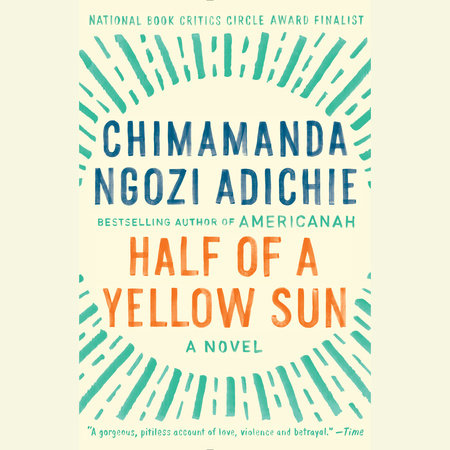
Since the Nigeria-Biafra civil war of 1967-70 which resulted in the mass killings of Igbo migrants living in northern Nigeria, some writers, particularly those of Nigerian descent, have attempted to document this piece of historical moment in their work, either as a sense of nationalism or their version of the truth. Chinua Achebe used two dominant characters, Odili and Chief Nanga in A Man of the People to describe the political views of two Nigerian generations: an intellectual group and a more traditional one, ending the narrative with a presage of the revolutionary war. Another one of Nigeria’s own, Abiodun Adekunle, son of Brig. Benjamin Adekunle a.k.a The Black Scorpion, leader of the Third Marine Commando Division of the Nigerian Federal Army during the time of the war, compiled and edited “The Nigeria-Biafra War Letters: A Soldier’s Story (Vol.1).” In these writings Adekunle seemed to be attempting to tell his father’s side of the story in the hopes of overshadowing misconstrued views some Nigerians may have of his father’s leadership. Ethnic nationalism, which appeared to be a major cause of the war, still to some extent, divides the people of Nigeria, with Igbos asserting that they are marginalized while the campaign for Biafra’s resurrection allegedly still continues. A report in July 2006 claimed that Igbo traders in Onitsha, Nigeria’s biggest market were accepting Biafran currency over Nigeria’s.
It is fascinating to see what ethnocentrism evokes in a person: the desire to defend your people and fight for them, to stand for who you are even if it means getting killed. Chinua Achebe writes about the war in his poetry collection Christmas in Biafra and Other Poems recounting from “The First Shot” to “After [the] War” in succinctly detailed stanzas. In her enthralling novel Half of a Yellow Sun, Chimamanda Ngozi Adichie captures the same historical moment, this time with fictionalized “truths” of what occurred. By using characters that represented different social classes, she attempts to create a realistic picture of the broken dreams and relationships that were a result of the war, showing that everyone was affected somehow.
Odenigbo, referred to as “Master,” is a professor whose revolutionary passions confuses and frightens Ugwu, his thirteen-year-old houseboy. At their first meeting Odenigbo relaxes while focusing on his reading, ignoring Ugwu who is waiting for his Master to initiate a conversation. After what seems like a lifetime, he startles Ugwu when he asks, “What is your name?” disrupting the thoughts of a village boy absorbed by his surroundings.
At one point Odenigbo’s attempts to rub off his suspicion of politicians and Western leadership on Ugwu only alarms the houseboy, especially when his Master tells him that, “There are two answers to the things they [the school] will teach you about your land: the real answer and the answer you give in school to pass.” All Ugwu can say to these and any reasoning given are “yes, sah,” even though he does not understand why his Master is so offended.
Adichie often drifts into the mind of Ugwu’s humorous character to portray not just a silly boy but also one exploring the adventurous side of adolescence. On his first night sleeping on a soft spring mattress at Master’s house, Ugwu decides not to have any sexual fantasies of Nnesinachi, his crush in the village. Sadly, she only views him as her brother, something that annoys Ugwu. Living with Odenigbo is one of the best things that has ever happened to Ugwu. He tries to win Master’s favor by doing everything right, too right sometimes that one day he burns Master’s socks when he tries to iron it, causing Odenigbo to call him a “stupid ignoramus.” This incident, however, only leaves Ugwu shaking, scared that Odenigbo is going to fire him. In an act of desperation Ugwu blames the evil spirits for making him iron the socks, affirming, “They lurked everywhere.” Everything seems fine after four months of living in the house until Ugwu begins to feel threatened by Olanna, a woman with a slight British accent who later moves in with them; one Master refers to as “very special.” She is the professor’s mistress, as Ugwu soon finds out, and she has chosen life in Nsukka, a university town, over that of a prestigious one in Lagos. But life with her turns out to be good after all as Ugwu finds himself, like everyone else, smitten by her beauty and charm. Meanwhile, the character of Kainene, the mysterious and unattractive twin sister of Olanna, intrigues Richard, a shy English writer who finds himself glued to her for reasons he cannot fathom throughout the first section of the novel.
Olanna is depicted as a very needy and emotionally dependent woman, and she is despised by Mama, Odenigbo’smother, for being “abnormal” because she was not breastfed by her mother as a baby. Mama’s animosity towards Olanna later diverts to her infertile womb.
In the beginning of the novel, words such as “Master,” “yes sah,” “slippers making slap-slap sounds that echoed in the streets,” only leaves the reader with a realistic imagination of the setting. Adichie uses the first part which is set in the early sixties not only to establish the political atmosphere of the country and the world through Odenigbo’s intellectual conversations with his friends, but also to introduce the lifestyle of the people of Nigeria at the time, and perhaps even now. However, the lifestyle of the characters becomes redundant and almost predictable, with Ugwu’s explicit sexual fantasies, Olanna’s compromising relationship with Odenigbo, and the evening gathering at Master’s house all leave the reader to wonder where the height of the story begins. But the occurrence of the war eventually sets everything into motion.
Chinua Achebe captures this horrendous moment in Nigeria’s history in his poem “Christmas in Biafra” dated 1969 in Christmas in Biafra and Other Poems. He describes the time as “This sunken-eyed moment wobbling down the rocky steepness on broken bones…in another year a lost Christmas irretrievable…to the peacefulness of a cool twinkling star…to death-cells of that moment came faraway sounds of other men’s carols floating on crackling waves mocking us with regret? Hope? Longing? None of these, strangely, not even despair rather distilling pure transcendental hate….” He describes his experience with a mixture of sadness, defeat and hope.
Adichie however, takes a slightly different course in Half of a Yellow Sun; up until the second half of the book (the early sixties), she paints the picture of a normal life among Nigeria’s Igbo population. And then, by the late sixties, as these characters begin to progress to the next stages of their lives, political tension in the country elevates to what eventually turned into a massacre of the Igbos.
At the height of the war Olanna comes upon the brutally murdered bodies of some of her family in Sabon Gari at her uncle Mbaezi’s compound. An experience that leaves her paralyzed for months: “Uncle Mbaezi’s [body] lay facedown in an ungainly twist, legs splayed. Something creamy-white oozed through the large gash on the back of his head. Aunty Ifeka lay on the veranda. The cuts on her naked body were smaller, dotting her arms and legs like slightly parted lips,” murders of a few of the many. But the gruesome scenes do not end at Olanna’s uncle’s house. The train back to Nsukka is horded with Igbos fleeing the town to a safer area; in it a woman carried a calabash with the braided head of her dead little girl whose eyes were rolled-back and mouth stayed open. Adichie incorporates more of these gruesome and realistic images throughout the war portion of the novel, evoking much emotion from the reader.
The final part of Half of a Yellow Sun captures the final part of the war in the late sixties to early seventies with images like the “half of a yellow sun” in the Biafra flag, giving more meaning to the title of the novel, at least to the reader who knew nothing of the emblem. Although such sour relationships as Olanna’s and Richard’s are mended, hers and Odenigbo’s fell apart. Olanna begins to discover herself as a woman at the end and becomes less needy and dependent on her emotions. Kainene however, never returns from her trip to Ninth Mile to trade across enemy lines for food and so is assumed dead, a devastating thought Olanna could not live with as she just mended another sour relationship with her twin whom she dearly loved. Indeed Adichie’s creation of the characters and her ability to make them come alive counts as one of the most fascinating features of the novel.
Adichie does a remarkable job of using related stories told by her family who experienced the war first-hand, either as army officers or civilians. You wonder how one could create a vivid yet fictionalized description of maimed and murdered bodies without being present. Half of a Yellow Sun proves to be a very engaging and striking novel that represents a significant moment in Nigerian history worth preserving.






